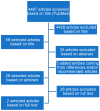Quality of Active versus Spontaneous Reporting of Adverse Drug Reactions in Pediatric Patients: Relevance for Pharmacovigilance and Knowledge in Pediatric Medical Care
- PMID: 36145369
- PMCID: PMC9503115
- DOI: 10.3390/ph15091148
Quality of Active versus Spontaneous Reporting of Adverse Drug Reactions in Pediatric Patients: Relevance for Pharmacovigilance and Knowledge in Pediatric Medical Care
Abstract
For drug safety in pediatric patients, knowledge about adverse drug reactions (ADRs) is essential to balance benefits and risks, especially because of the high incidence of off-label drug use. However, underreporting of ADRs is a serious problem, leading to a deficit in knowledge affecting clinical practice. The aim of this study is to find a method by which we can improve the quantity of ADR reporting while maintaining or improving the quality of the ADR reports. This was done in several steps. First, health care providers were educated to increase awareness of ADRs. Thereafter, a novel active supporting system was introduced, where reporting ADRs was simplified; if clinical physicians suspected an ADR, they only had to send the name or hospital number of the patient, the observed ADR, and the suspected drug to a supportive team. This team collects all information needed about the possible ADR from the patient's medical records and hospital charts. With this information, the supportive team fills in the forms necessary for reporting ADRs to the nationwide pharmacovigilance centre Lareb. With this system, the quantity of ADR reports from both inpatients and outpatients rose dramatically. Subsequently, the quality of the obtained ADR reports was measured using the ClinDoc and vigiGrade systems. This study shows there is no loss of quality of the ADR reports in the active reporting system compared to spontaneous reporting systems. Based on the data of the present study, we suggest that an active reporting system has the potential to increase our knowledge about ADRs in pediatric patients.
Keywords: active reporting ADRs; adverse drug reactions; drug safety; pharmacovigilance; quality of ADR reports.
Conflict of interest statement
The authors declare no conflict of interest.
Figures




Similar articles
-
Adverse Drug Reactions in Children: Comparison of Reports Collected in a Pharmacovigilance Project Versus Spontaneously Collected ADR Reports.Paediatr Drugs. 2023 Mar;25(2):203-215. doi: 10.1007/s40272-022-00540-z. Epub 2022 Nov 12. Paediatr Drugs. 2023. PMID: 36369590 Free PMC article.
-
Current Scenario and Future Prospects of Adverse Drug Reactions (ADRs) Monitoring and Reporting Mechanisms in the Rural Areas of India.Curr Drug Saf. 2024;19(2):172-190. doi: 10.2174/1574886318666230428144120. Curr Drug Saf. 2024. PMID: 37132145 Review.
-
Analysis of Reporting Adverse Drug Reactions in Paediatric Patients in a University Hospital in the Netherlands.Paediatr Drugs. 2020 Aug;22(4):425-432. doi: 10.1007/s40272-020-00405-3. Paediatr Drugs. 2020. PMID: 32557243 Free PMC article.
-
Monitoring drug safety in Astrakhan, Russia.Int J Risk Saf Med. 2015;27 Suppl 1:S33-4. doi: 10.3233/JRS-150680. Int J Risk Saf Med. 2015. PMID: 26639700
-
Evaluation of patient reporting of adverse drug reactions to the UK 'Yellow Card Scheme': literature review, descriptive and qualitative analyses, and questionnaire surveys.Health Technol Assess. 2011 May;15(20):1-234, iii-iv. doi: 10.3310/hta15200. Health Technol Assess. 2011. PMID: 21545758 Review.
Cited by
-
Guillain-Barré syndrome and checkpoint inhibitor therapy: insights from pharmacovigilance data.BMJ Neurol Open. 2024 Mar 13;6(1):e000544. doi: 10.1136/bmjno-2023-000544. eCollection 2024. BMJ Neurol Open. 2024. PMID: 38501128 Free PMC article. Review.
-
Do peripheral neuropathies differ among immune checkpoint inhibitors? Reports from the European post-marketing surveillance database in the past 10 years.Front Immunol. 2023 Mar 16;14:1134436. doi: 10.3389/fimmu.2023.1134436. eCollection 2023. Front Immunol. 2023. PMID: 37006303 Free PMC article.
-
Pharmacovigilance Strategies to Address Resistance to Antibiotics and Inappropriate Use-A Narrative Review.Antibiotics (Basel). 2024 May 16;13(5):457. doi: 10.3390/antibiotics13050457. Antibiotics (Basel). 2024. PMID: 38786184 Free PMC article. Review.
References
LinkOut - more resources
Full Text Sources
Research Materials

